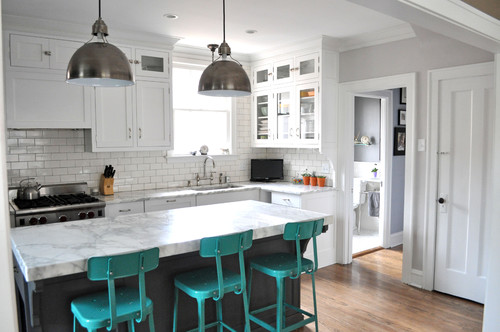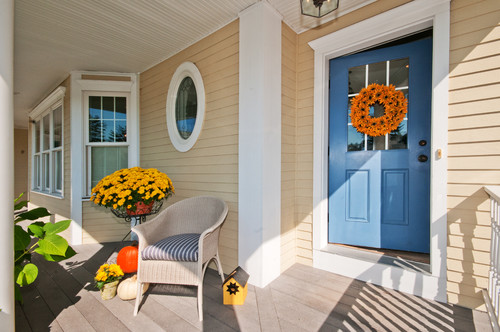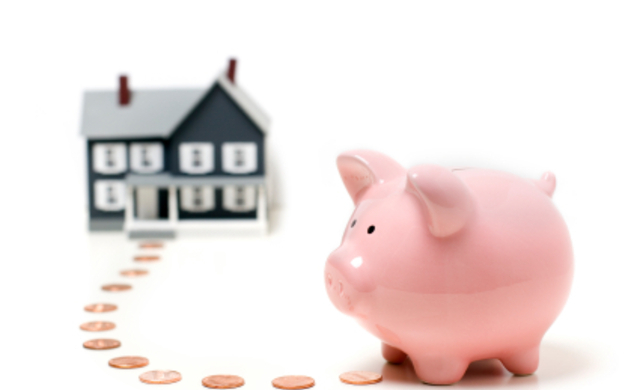When it comes to staging a home for sale, the classic advice to keep color schemes neutral is still spot-on. White or pale hues make a space feel simple, serene and more expansive. These unobtrusive colors act as a blank canvas; they allow potential buyers to imagine themselves living in the home.
But many homeowners who already have colorful walls or furniture may wonder if it’s possible to keep some color in their staged home. The answer is absolutely yes. You can maintain – or even add – just a pop of color to create the right amount of personality and style in your staging. In fact, a splash of color can make a space feel designed, perhaps allowing it to linger in the memories of prospective buyers. As a bonus, color can also brighten your listing photos. Remember, you’ll want to add the color only after you’ve done the first two steps of home staging, paring down and freshening up. Here’s a game plan for strategically adding color to each staged room of your home.
Brighten the Living Room
Throw pillows are easily found and often cost-efficient. On a sofa, they’re a terrific way to add a burst of color. Select throw pillows that complement the sofa and room. You might go for a bright contrast, like royal blue against white, or bright yellow on a beige sofa. It’s all right to choose patterned, floral, solid or metallic versions. The key is to look for a color or combination of colors that will add visual interest without taking over the room.
Color-coordinating your display shelves is another smart and budget-friendly way to infuse your living room with a little color. When editing your bookcase or shelves, try keeping books of the same color or combinations of colors together. You might be surprised how a simple stack of brightly colored red or blue books can transform a shelf or an accent table.
If the thought of parting with that pair of brightly colored armchairs gives you trouble, rest assured that you might not have to let them go. Once you’ve given the room a neutral and soothing palette overall, try reinstating that colorful furniture piece or accessory. Perhaps balance it out with a paler counterpart, as with a light-colored throw on a chair, or white books on a colorful table.
The rule of thumb is that if it’s a visual distraction, you should remove it. But if your punchy piece complements the space and adds just the right amount of personality, it can stay. A buyer might remember the cool house with the interesting blue velvet ottoman, especially among a sea of all-white homes with nothing memorable about them.
Bring a Splash of Color to Your Kitchen
Look to surfaces such as a countertop, an open shelf or a stovetop as opportunities to add a pop of color here and there in the kitchen. You don’t want to introduce clutter, but you could replace necessary items — teakettle, dish towel, cookie jar — that are neutral with colorful equivalents that tastefully brighten the space.
A terrific option for adding color to a kitchen is to highlight colorful seating options. Bright bar stools or dining chairs can really make a kitchen come to life.
Another great idea for adding temporary color that many stagers use for both photos and open houses is a simple bowl of fruit on the counter. Try using a single color, such as all green or all red apples. For a warm personal touch at your open house, you might leave a note offering the fruit to your visitors.
A Bedroom That Oozes Calm
A well-staged bedroom should feel like a relaxing hotel room, with nothing too personal showing. Pale or white bedding and minimal accessories will contribute nicely to a soothing scheme.
Adhering to a hotel-like feel for your bedroom, however, doesn’t mean that you can’t add a color or two. Your bed wall is the perfect place to feature a different hue. Stick to peaceful or classic colors that will work nicely with your neutral bedding. White or ivory bedding looks sophisticated against a navy wall. Similarly, a soothing aqua or pale blue painted wall would freshen up a drab or dark space, making it more inviting and relaxing. Add a mirror to your painted bed wall to help create an elegant and calming retreat.
As with the living room, you can also opt for colored throw pillows or one colorful piece of accent furniture to add subtle drama to the bedroom. As long as it doesn’t detract from enhancing the room’s size and relaxing nature, a little color can brighten a bedroom nicely.
Bathrooms Are for Color
Fresh and clean is how you want your bathroom to read to any prospective buyer. Crisp white towels and a sparkling shower or tub do wonders to brighten an outdated or worn bathroom. Surprisingly, so does a little color on the walls.
So if your bathroom still feels a bit drab after cleaning and updating the space with new hardware and a fresh glaze on the tub, try painting one or more walls in a classic or fresh color. This can add a bit more style to the room, with the added perk of helping to conceal aging walls and distract the eye from other outdated features.
Look to classic colors like navy or charcoal gray to pop against your fluffy white towels or help make white tiles look brighter. Alternatively, a refreshing color such as pale aqua can evoke the palette of clean water, resulting in a soothing feeling.
Colors you might steer clear of for a painted bathroom wall are nonsoothing brights such as orange or emerald green. While these primary colors can make a fun statement, they don’t evoke a serene or clean feeling for the purposes of a bathroom.
Dress Up Your Exterior
Last but not least, it’s time to address accenting the exterior of your home with a burst of color. Painting your front door and shutters in a color that coordinates with the rest of your house will add curb appeal.
Bright and classic colors such as red, green and blue are great options, especially to coordinate with planters and brightly colored flowers.
As an added element, look to the season to dictate your choice of flower and splashes of color. Red tulips are fantastic in the springtime, while orange and yellow give a sunny glow to a home in the fall.
WRITTEN BY NEILA DEEN, HOUZZ










 There are a number of ways to increase your purchasing power and bring real estate ownership within reach. The important thing is not to give up on making an effort before you have explored opportunities available to you in this real estate market:
There are a number of ways to increase your purchasing power and bring real estate ownership within reach. The important thing is not to give up on making an effort before you have explored opportunities available to you in this real estate market: Small changes to the entryway can have a dramatic impact on visitors. Replace broken or rusted lighting fixtures, update door hardware, and
Small changes to the entryway can have a dramatic impact on visitors. Replace broken or rusted lighting fixtures, update door hardware, and 


 There’s also been a trend to paint just the front door a deep, rich color like red. This may not be appealing to all. However, buyers would tend to overlook it because it’s a simple change as well as one that can easily and cheaply be changed to the new
There’s also been a trend to paint just the front door a deep, rich color like red. This may not be appealing to all. However, buyers would tend to overlook it because it’s a simple change as well as one that can easily and cheaply be changed to the new 





 Houzz
Houzz 

